Art Deco Jadeite Necklace- A Lesson in Appraising Jade
June 22nd, 2010 by James L. Sweaney, CGA, FGA. GG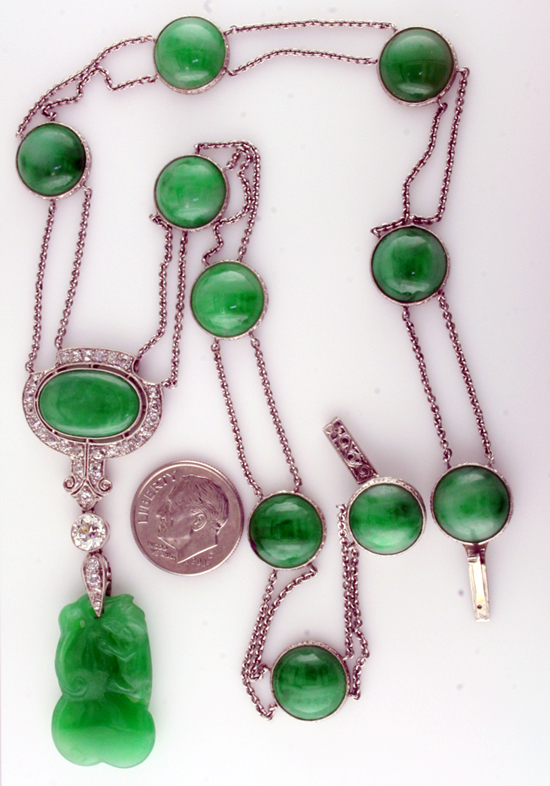
Art Deco Jadeite Necklace
We’ve been working on an insurance appraisal for this wonderful platinum necklace with diamonds and jadeite from the 1920’s and realized the piece has a lot to teach about grading and valuing jade.
Jade is not well understood by many folks. If I told you that jade can be one of the most expensive of all gemstones, you would probably be surprised– some pieces sell for well into six figures. Even jewelers who really know their way around the faceted stones have a hard time with jade, so we don’t often see really good jade like this necklace.
Jade is actually two different minerals. Nephrite is the one we see in ancient chinese carvings and artifacts, while jadeite, discovered in Burma (Myanmar) in the early 1800’s, is the more valuable type used in jewelry.
The more vivid and translucent colors of jadeite, especially the emerald green known as “Imperial” or “Kingfisher” are highly sought after, especially in Asia and can sell for truly astounding prices. When we grade jade as a gemstone, we are usually talking about jadeite.
We grade quality in diamonds according to the 4 C’s. When we grade quality in jadeite, besides grading the color as we do in other colored gemstones, we evaluate what I call “the 3 T’s”– translucence, texture, and tone.
Our Art Deco necklace is set with jadeite stones that blend well for color, but we can see different examples of the 3 T’s.

examples of the 3 T's
The carving of the gourd and cat is the highest quality in the necklace. While the tone of the green could be described as medium with strong saturation, it also exhibits a nice degree of translucence and the material has a very even texture so that we don’t really see individual particles within the jade, just a really nice “smooth” appearance. Even without the backlighting, the jade has a “glow” where the rich color seems to come from within rather than from the surface.
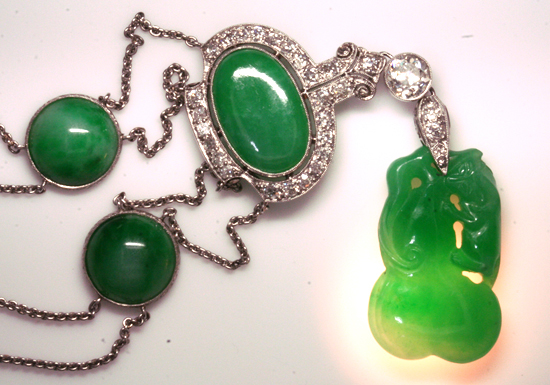
The oval cabochon in the center of the necklace has a similar tone of green, but while the texture is even, you can see a slight graininess and the translucence is not at the same level, so the color is not as saturated.
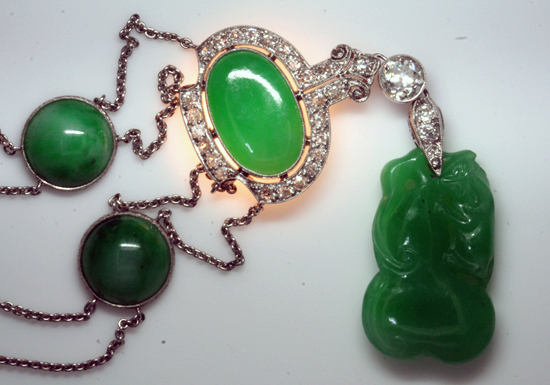
Oval Jadeite with backlight
The round cabs in the necklace have a similar hue of green that blends well with the two center stones, but the tone is variable with light and dark areas, the texture is somewhat grainy, and the translucence is less.
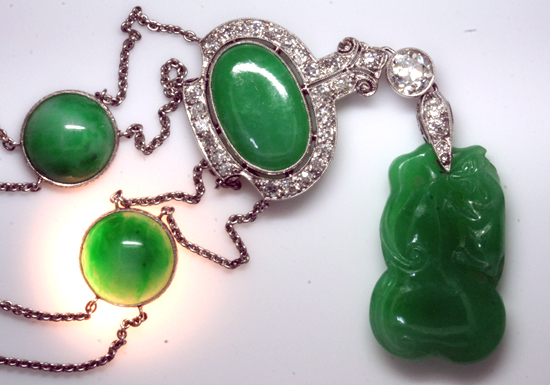
Round jadeite with backlight
The carved jadeite is beginning to approach what we might call Imperial- the hue and tone of green and the even texture are about right, but Imperial jadeite is semi-transparent rather than translucent, and the color saturation is more vivid. Overall, the necklace is a beautiful piece typifying the Art Deco ethic and a wonderful example of the range and subtlety of jadeite.



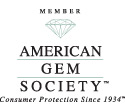




July 22nd, 2010 at 12:08 pm
Jim,
I think your piece is excellent! I wish more people understood jadeite as you obviously do. You provide a very good description of quality components for jadeite. The only criticism I might have would be the fact that although you reference color, you may not have stressed the importance of color enough as it relates to quality and of course, value. Having been in the jade business for over 25 years myself (and 34 years as a company) I always try to communicate that like in almost all other colored stones, while texture and especially translucency are important in jadeite, ‘color is king’… Still, a great blog post!
Jeff Mason, Mason-Kay, Inc.